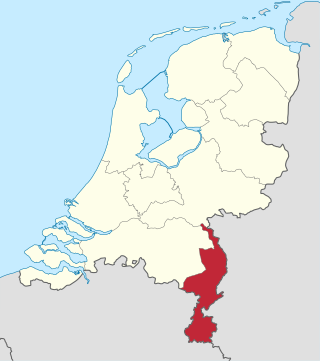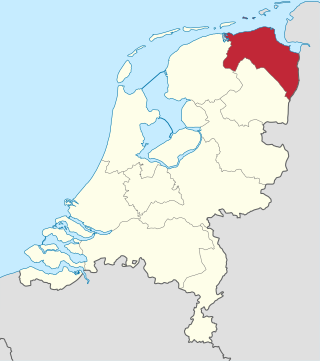
Limburg, also known as Dutch Limburg, is the southernmost of the twelve provinces of the Netherlands. It is bordered by Gelderland to the north and by North Brabant to its west. Its long eastern boundary forms the international border with the state of North Rhine-Westphalia in Germany. To the west is the international border with the similarly named Belgian province of Limburg, part of which is delineated by the river Meuse. To the South, Limburg is bordered by the Belgian province of Liège. The Vaalserberg is on the extreme southeastern point, marking the tripoint of the Netherlands, Germany and Belgium.

Groningen is the northeasternmost province of the Netherlands. It borders on Friesland to the west, Drenthe to the south, the German state of Lower Saxony to the east, and the Wadden Sea to the north. As of January 2023, Groningen had a population of about 596,000, and a total area of 2,955 km2 (1,141 sq mi).

Drenthe is a province of the Netherlands located in the northeastern part of the country. It is bordered by Overijssel to the south, Friesland to the west, Groningen to the north, and the German state of Lower Saxony to the east. As of January 2023, Drenthe had a population of about 502,000, and a total area of 2,680 km2 (1,030 sq mi).

Overijssel is a province of the Netherlands located in the eastern part of the country. The province's name translates to "across the IJssel", from the perspective of the Episcopal principality of Utrecht by which it was held until 1528. The capital city of Overijssel is Zwolle and the largest city is Enschede. The province had a population of about 1,184,000 as of January 2023. The land mostly consists of grasslands and some forests ; it also borders a small part of the IJsselmeer to the west.

There are twelve provinces of the Netherlands representing the administrative layer between the national government and the local governments, with responsibility for matters of subnational or regional importance.

Wageningen is a municipality and a historic city in the central Netherlands, in the province of Gelderland. It is famous for Wageningen University, which specialises in life sciences. The municipality had a population of 39,635 in 2021, of which many thousands are students from over 150 countries.
Regional routes are the third category of road in the South African route numbering scheme. They are designated with the letter "R" followed by a three-digit number. They serve as feeders connecting smaller towns to the national and provincial routes. Designation as a regional road does not necessarily imply any particular size of road; they range from gravel roads to multi-lane freeways.
Pero is a West Chadic language of Nigeria.

Provincial road N34 is a Dutch provincial road that links the N36 near Ommen, Overijssel to Rijksweg 28 near De Punt, Drenthe. The entire road is an expressway, of which the part between Coevorden and Emmen-West consists of two lanes in each direction.
Lensworld–Kuota is a former professional cycling team based in Belgium, which competed in elite road bicycle racing events such as the UCI Women's Road World Cup.

The Netherlands has a public road network totaling 139,000 km, one of the densest in the world. Its use has increased since the 1950s and now exceeds 200 billion km traveled per year, three quarters of which is by car, making it among the most intensely used road networks. In 2019, the World Economic Forum ranked the quality of Dutch road infrastructure as the best in Europe and second to Singapore out of 141 countries.

Provincial road N201 is a Dutch provincial road.

Provincial road N707 (N707) is a road connecting N306 and N302 near Harderwijk with Zeewolde.

Provincial road N708 (N708) is a road connecting N709 near Biddinghuizen with N306 near Biddinghuizen]].
Provincial road N434 is a planned Dutch provincial road that will connect the A4 motorway with the A44 motorway near Leiden.

National Route 305 (N305) forms a part of the Philippine highway network. It is a secondary road that acts as a four-lane spur road that spans 1.7 kilometers (1.1 mi) and consists two major streets in Olongapo, serving as the main road of Olongapo city proper.

The H. J. Lovink Pumping Station is a pumping station in Biddinghuizen, a village in the municipality of Dronten, Flevoland, the Netherlands. Named for Hermanus Johannes Lovink, an agriculturist who was extensively involved in land reclamation, the station was designed by Dirk Roosenburg and completed in 1956. It was used for the reclamation of the eastern Flevopolder in 1957, and contributed to the reclamation of the island's southern areas. The station was designated a rijksmonument on 13 December 2010.
This page is based on this
Wikipedia article Text is available under the
CC BY-SA 4.0 license; additional terms may apply.
Images, videos and audio are available under their respective licenses.















